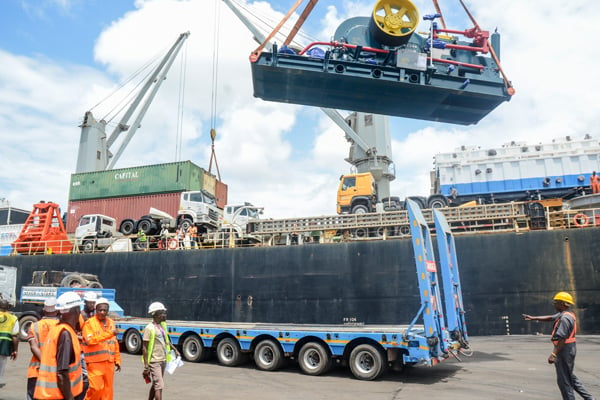Prime
Local firms cash in on oil sector tenders

Loading of parts of the Kingfisher oil rig at Mombasa port, Kenya. Photo/Frederic Musisi
What you need to know:
- Mr Ernest Rubondo, the executive director of PAU, says they are also pushing for more joint ventures between Uganda and foreign companies to increase value and knowledge/ skills transfer.
Last week’s news of the arrival of parts for the Kingfisher oil field drilling rig was widely celebrated as another breakthrough for Uganda getting closer to commercial oil production in the last quarter of 2025.
One key detail footnoted in the celebrations is that a local company, DDG Logistics Ltd, was subcontracted to haul the LR8001 rig from Mombasa Port in Kenya to the oil field at the parallels of Lake Albert. The rig will be used to drill 33 wells at the Kingfisher Development Area in Kikuube.
Chinese oil company, Cnooc Uganda Ltd, handed the tender to China Oilfield Services (COSL) Uganda Smc Ltd which subcontracted local logistics company, RI Distributors Ltd, to clear the rig through the customs bureaucracy at Mombasa and haulage to Kikuube.
However, given the scale and scope of the haulage assignment requiring more than 250 trucks, RI Distributors also subcontracted the joint venture of DDG Logistics.
The joint venture involves five companies namely RI Distributors Ltd, DT Logistics Ltd, Globetrotters Ltd, Daks Couriers Ltd, and RichFlo Lift Services Ltd.
“We formed DDG Logistics last year in preparation for complex jobs such as the rig move. By delivering the first rig to Kingfisher, we have demonstrated DDG Logistics’ readiness to serve in the highly competitive oil and gas industry,” Mr David Kasingwire, the DDG Logistics Ltd chairman, said.
According to the terms, the company is supposed to haul the rig parts from Mombasa to the oil field within 35 days from the date the vessel arrives at Mombasa. This means more than 250 road trips will be taken to haul parts of the rig over a distance of close to 1,800km.
Transport and Logistics is one of the 16 turfs ring-fenced for local companies, according to the upstream and midstream National Content regulations issued in 2016. Others are land surveying, clearing and forwarding, security, foods and beverages, hotel and accommodation, fuel supply, among others.
While in policy documents, transport and logistics for the oil sector is reserved for indigenous players, Mr Kasingirwe told this publication at the weekend it is very capital intensive.
“While it is a protected space, it is not easy to get in. The oil industry requires service providers to have very high standards covering management, health and safety, and environment protection to mention but a few. They also require strong balance sheets and liquidity. Working as a joint venture helped us to achieve all the above. Individually, none of us would be able to execute such a project.”
The company sees more transport opportunities over the next three to five years such as Tilenga Project and the construction of the East African Crude Oil Pipeline (EACOP), haul line pipes and other materials through the mainland Tanzania en route to Uganda.
The Uganda section of EACOP is 296km through 10 districts of Hoima, Kikuube, Kakumiro, Kyankwanzi, Mubende, Gomba, Sembabule, Lwengo, Rakai and Kyotera.
The oils sector regulator, Petroleum Authority of Uganda (PAU) estimates that at least 8 million tonnes of equipment will be sourced domestically, regionally, and internationally during the ongoing construction phase which means big business for the transport and logistics business.
Since the announcement of Final Investment Decision (FID) earlier in February, PAU says over 174 contracts valued at over $6.5b (Shs24 trillion) have been awarded, of which contracts worth $1.7b (Shs6.5 trillion) have been awarded to Ugandan companies, directly at Tier 1 ($933)—or Shs3.5t — and through subcontracting commitments at Tier 2 ($745m)—or Shs2.8 trillion.
The estimated value to Ugandan entities to date, according to PAU, is estimated to be 25 percent while the foreign companies which have been awarded contracts at Tier 1 and Tier 2 levels are expected to sub-contract more to Ugandan companies, at the lower levels of contracting. This is expected to increase the participation of Ugandan entities in the sector towards the targeted 40 percent participation.
Joint ventures
Mr Ernest Rubondo, the executive director of PAU, told this publication yesterday that with the flurry of activity in the sector “we are seeing more Ugandan companies participating and working together to undertake bigger scopes of work.”
He said they are also pushing for more joint ventures between Uganda and foreign companies to increase the value in the country’s economy and knowledge/ skills transfer.
“The oil and gas contracts are of high value with the ‘small’ ones being in tens of millions, and big ones in hundreds of millions. It’s important that we see Ugandan companies coming together or partnering with international companies to undertake this work. With this progress, we expect to meet or even surpass the national content targets for the oil activities,” Mr Rubondo said.
The trickledown effect through the lucrative contracts and subcontracts is employment in terms of both direct and indirect jobs. At the end of June, according PAU, at least 5,624 people were directly employed by the sector of which, 95 percent were Ugandans.




